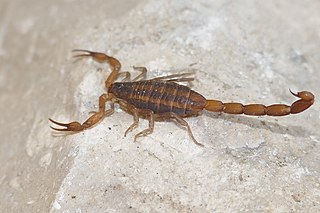
The emperor scorpion(Pandinus imperator) is a species of scorpion native to rainforests and savannas in West Africa. It is one of the largest scorpions in the world and lives for 6–8 years. Its body is black, but like other scorpions it glows pastel green or blue under ultraviolet light. It is a popular species in the pet trade, and is protected by CITES to prevent over-collecting that might affect the species' survival.

The Arizona bark scorpion is a small light brown scorpion common to the Sonoran Desert in the southwestern United States and northwestern Mexico. An adult male can reach 8 cm in length (3.14 inches), while a female is slightly smaller, with a maximum length of 7 cm (2.75 inches).

The striped bark scorpion is an extremely common scorpion found throughout the midsection of the United States and northern Mexico. It is perhaps the most frequently encountered scorpion in the U.S.
Bark scorpion may refer to:

A scorpion sting is an injury caused by the stinger of a scorpion resulting in the medical condition known as scorpionism, which may vary in severity. The anatomical part of the scorpion that delivers the sting is called a "telson". In typical cases, scorpion stings usually result in pain, paresthesia, and variable swelling. In serious cases, scorpion stings may involve the envenomation of humans by toxic scorpions, which may result in extreme pain, serious illness, or even death depending on the toxicity of the venom.
Birtoxin is a neurotoxin from the venom of the South African Spitting scorpion. By changing sodium channel activation, the toxin promotes spontaneous and repetitive firing much like pyrethroid insecticides do
Bestoxin is a neurotoxin from the venom of the South African spitting scorpion Parabuthus transvaalicus. Most likely, it targets sodium channel function, thus promoting spontaneous and repetitive neuronal firing. Following injection into mice, it causes non-lethal writhing behaviour.

Mesobuthus eupeus is a polymorphic scorpion species belonging to the well-known family Buthidae. Commonly known as the lesser Asian scorpion or the mottled scorpion. It is thought to be the most widely dispersed species of the genus Mesobuthus, perhaps even of the family Buthidae.
Centruroides baergi is a species of scorpion in the family Buthidae. They are commonly found in highlands and are almost exclusively found in the states of Oaxaca and southern Puebla, Mexico. C. baergi is the most abundant scorpion of the genus in the state of Oaxaca, making up a third of Centruroides reported between 2008 and 2014.
Ergtoxin is a toxin from the venom of the Mexican scorpion Centruroides noxius. This toxin targets hERG potassium channels.

Toxin Cll1 is a toxin from the venom of the Mexican scorpion Centruroides limpidus limpidus, which changes the activation threshold of sodium channels by binding to neurotoxin binding site 4, resulting in increased excitability.
Centruroides suffusus suffusus toxin II (CssII) is a scorpion β-toxin from the venom of the scorpion Centruroides suffusus suffusus. CssII primarily affects voltage-gated sodium channels by causing a hyperpolarizing shift of voltage dependence, a reduction in peak transient current, and the occurrence of resurgent currents.

Noxiustoxin (NTX) is a toxin from the venom of the Mexican scorpion Centruroides noxius Hoffmann which block voltage-dependent potassium channels and calcium-activated potassium channels.
Beta-mammal toxin Cn2, also known as Cn2 toxin, is a single chain β-scorpion neurotoxic peptide and the primary toxin in the venom of the Centruroides noxius Hoffmann scorpion. The toxin specifically targets mammalian Nav1.6 voltage-gated sodium channels (VGSC).
Beta-toxin Cll2, shortened to Cll2, is a toxin in the venom of the Mexican Scorpion species Centruroides limpidus limpidus. The toxin belongs to the β-class family of sodium channel-inhibiting scorpion toxins. It affects voltage-dependent activation, conductance and resurgent currents of voltage gated sodium channels by binding to site 4.

Scorpionism is defined as the accidental envenomation of humans by toxic scorpions. If the injection of venom in a human results in death, this is defined as scorpionism. This is seen all over the world but is predominantly seen in the tropical and subtropical areas. These areas include Mexico, northern South America and southeast Brazil in the Western hemisphere. In the Eastern hemisphere, scorpionism possess a public health threat in the regions of South Africa, the Middle East, and the Indian subcontinent.
The CmERG1 toxin is a peptide composed of 42 amino acids, found in venom from the Colombian scorpion Centruroides margaritatus. It blocks human ether-a-go-go-Related gene (hERG) potassium channels, which are important for cardiac action potential repolarization.

Centruroides hentzi, the Hentz striped scorpion, is a species of bark scorpion in the family Buthidae. They are native to the southeastern United States including the states of Florida, southwestern Alabama, and in the coastal plain of Southern Georgia including surrounding barrier islands. C. hentzi is present in other states such as North Carolina and South Carolina due to accidental human importations.
Cm28, a scorpion toxin from Centruroides margaritatus, selectively blocks voltage-gated potassium channels KV1.2 and KV1.3 with high affinity. It also suppresses the activation of human CD4+ effector memory T cells, suggesting its potential as a therapeutic agent for autoimmune diseases. Phylogenetic analysis reveals that Cm28 belongs to a new α-KTx subfamily, highlighting its unique structural and functional properties for potential drug development.
Tityus stigmurus toxin 1 (Tst1) is a neurotoxin found in the venom of the Brazilian scorpion, Tityus stigmurus. It acts on voltage-gated sodium channels (Navs), altering opening and inactivation voltages, recovery from inactivation, and overall current flow.









